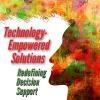Strategic advice to leverage new technologies
Technology is at the heart of nearly every enterprise, enabling new business models and strategies, and serving as the catalyst to industry convergence. Leveraging the right technology can improve business outcomes, providing intelligence and insights that help you make more informed and accurate decisions. From finding patterns in data through data science, to curating relevant insights with data analytics, to the predictive abilities and innumerable applications of AI, to solving challenging business problems with ML, NLP, and knowledge graphs, technology has brought decision-making to a more intelligent level. Keep pace with the technology trends, opportunities, applications, and real-world use cases that will move your organization closer to its transformation and business goals.
Recently Published
For most organizations that have deployed customer experience (CX) practices and technologies, it is still too early to tell if their efforts have actually allowed them to deliver a better customer experience. However, for approximately 31% of the organizations that have deployed CX practices and technologies, their initial efforts appear to be paying off. These findings come from the preliminary results of an ongoing CX management survey we are conducting.
Agile Approach to Designing for Consequences
This Executive Update introduces a timely, new Agile event: consequence scanning. This event fits into an iterative development cadence and allows organizations to consider the potential consequences of what is being built — early and often. We explain the need to embed proactive and dedicated consideration of potential consequences within an organization’s product development and outline how best to do it with consequence scanning.
There are a multitude of innovative applications across industries where RPA solutions are improving the quality of repeated tasks and releasing resources. In this Advisor, I share a sampling of a few interesting case studies and examples of RPA in action.
Michael Gleeson discusses how public health agencies and emergency managers can leverage the digitization of contact tracing of airline passengers at risk from a biological outbreak. He outlines the increased risk of infection and spread, facilitated by the increased numbers of airline passengers globally. A global framework to prepare for and respond to a biological threat, natural or otherwise, spread via air travel, can be achieved through the digitization of contact tracing using a collaborative approach among the airline industry, public health agencies, and EM practitioners. Identifying and locating at-risk passengers in a fast and efficient manner is paramount to limiting contagion spread.
Theresa Jefferson and Gloria Phillips-Wren discuss modeling for disaster response. This is vital for practitioner/manager decision making to reduce the impact of a natural or man-made disaster. The authors examine the concept of technology embeddedness, noting that emergency managers must trust the technology and show a preference to use it prior to an actual disaster; the time to integrate technology into disaster recovery operations is not during a disaster. They explain how to effectively appropriate, integrate, and use modeling technologies for disaster response and, therefore, recovery.
Frederic Adam and Paidi O’Raghallaigh tackle the current healthcare crisis. They shine a light on the opportunities provided by medical decision support for clinicians and patients and identify a number of challenges to achieving connected health, which they define as “the use of technology-based solutions to deliver healthcare services remotely.” The article proposes a connected health blueprint that may well pave the way for future connected health systems.
The challenge for this issue was to accurately represent the diversity of research in the DSS arena while also giving a glimpse of the cutting-edge DSSs of tomorrow.
Tom Butler and Leona O’Brien provide a timely perspective on AI in the financial industry. Their article provides a pragmatic perspective on the capabilities of AI and pours cold water on some of the hyperbolic claims made about AI and ML in the fintech and regtech space. The authors suggest a direction and guidelines for future research for AI to realize its potential in the financial services sector.






















